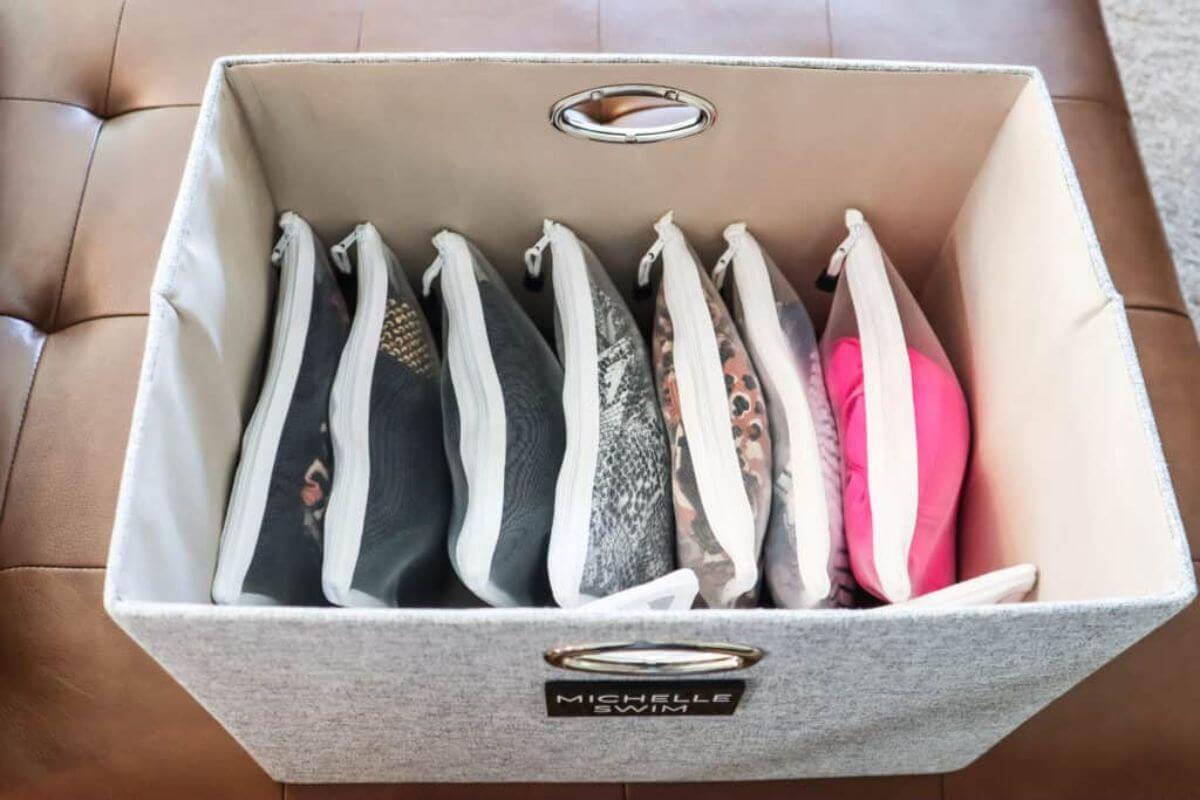Bathing suits, those cherished ensembles that accompany you to sun-soaked beaches and poolside getaways, deserve special care when it comes to storage. Whether you’re a dedicated swimmer or an occasional beachgoer, the right storage methods can help prolong the life and vibrancy of your bathing suits. In this comprehensive guide, we’ll explore the art of storing bathing suits to ensure they remain in perfect condition, ready for your next aquatic adventure.
Why Proper Storage Matters
Proper storage matters for several reasons when it comes to your bathing suits. Here are some key points that emphasize its importance:
Preserving Elasticity:
Bathing suits are designed with elastic materials that provide a snug and comfortable fit. Correct storage helps maintain this elasticity, preventing your suits from sagging or losing their shape over time.
Preventing Fading:
Exposure to sunlight, chlorine, and saltwater can cause the colors of your bathing suits to fade. Proper storage minimizes the amount of time your suits spend exposed to these elements, helping to maintain their vibrant appearance.
Avoiding Snagging and Damage:
Careful storage prevents your bathing suits from getting caught on zippers, buttons, or other clothing items. It also safeguards them from potential damage that can occur during storage.
Hygiene:
After use, bathing suits may contain residual salt, chlorine, or bacteria. Proper storage ensures that these elements do not linger on your suits, promoting better hygiene and preventing odors.

Extending Suit Lifespan:
When bathing suits are stored correctly, they can last longer. This helps you get more wear out of your favorite swimwear, saving you money and reducing the need for frequent replacements.
In conclusion, taking the time to store your bathing suits properly ensures that they remain in great condition, maintaining their fit, color, and overall quality for many beach days and poolside getaways to come.
The Ideal Storage Method
To keep your bathing suits in pristine condition, follow these ideal storage methods:
1. Rinse After Each Use:
- After wearing your bathing suit, rinse it in cool, freshwater. This helps remove salt, chlorine, and other residues that can damage the fabric.
2. Hand Wash:
- Occasionally hand wash your bathing suits using a mild detergent designed for delicate fabrics. Gently squeeze the water out and avoid wringing or twisting the material.
3. Avoid Machines:
- Machine washing and drying can be harsh on bathing suits, leading to wear and tear. Hand washing is a gentler alternative to maintain their quality.
4. Lay Flat to Dry:
- Lay your bathing suits flat on a towel to air dry. Avoid hanging them, as the weight of the water can cause stretching and misshaping.
5. Store Separately:
- Store each bathing suit separately to prevent color transfer or snags. Use separate storage bags or compartments.
6. Use Fabric Bags:
- Place your bathing suits in fabric bags or breathable pouches to protect them from dust and light. Avoid plastic bags, as they can trap moisture and promote mildew.
7. Cool, Dark, and Dry Location:
- Store your bathing suits in a cool, dark, and dry location away from direct sunlight. Prolonged exposure to sunlight can cause fading.
8. Rotate Suits:
- If you have multiple bathing suits, rotate their use. This prevents overstretching or excessive wear on a single suit.
Creative Storage Solutions
For those with a passion for swimwear, organizing your collection creatively can enhance your storage experience:
1. Hanging Swimsuit Organizer:
- Invest in a hanging swimsuit organizer with multiple compartments. This helps you neatly store and access your suits.
2. Drawer Dividers:
- Use drawer dividers to create separate sections for each bathing suit in your dresser or wardrobe.
3. Customized Hangers:
- Use padded or customized hangers designed for swimsuits. These prevent stretching and distortion.
4. Decorative Hooks:
- Hang decorative hooks in your closet or on the back of your bathroom door to store swimsuits individually.
In Conclusion
In conclusion, the proper storage of your bathing suits is a vital aspect of maintaining their longevity and quality. By following the recommended methods and best practices, you can ensure that your swimwear remains in perfect condition, ready for your next beach or poolside adventure. The benefits of proper storage are numerous:
Preserved Elasticity:
Storing your bathing suits correctly helps maintain the elasticity of the fabric, preventing sagging and misshaping.
Color Retention:
It minimizes exposure to factors like sunlight, chlorine, and saltwater, which can cause colors to fade.
Prevention of Snags and Damage:
Careful storage prevents your suits from getting caught or damaged during their downtime.
Enhanced Hygiene:
Proper storage ensures that your swimwear remains clean and fresh, free from the lingering residues of salt, chlorine, and bacteria.
Extended Lifespan:
With the right storage methods, your bathing suits can last longer, saving you money and reducing waste.
Whether you’re a frequent beachgoer or an occasional swimmer, taking the time to store your bathing suits properly is a small yet significant investment in preserving your favorite swimwear. It guarantees that you’ll enjoy many more seasons of stylish and comfortable aquatic experiences.
Certainly, here are some frequently asked questions (FAQs) related to the storage of bathing suits:
FAQS
1. How often should I wash my bathing suits before storing them?
It’s a good practice to rinse your bathing suit with freshwater after every use to remove salt, chlorine, and sunscreen. You should hand wash it with a mild detergent after every few wears or whenever it becomes noticeably dirty.
2. Can I store wet bathing suits?
It’s not recommended to store wet bathing suits for an extended period, as this can lead to mildew and an unpleasant odor. If you must store them temporarily, make sure they are completely dry before long-term storage.
3. Is it okay to fold bathing suits when storing them?
Folding your bathing suits is acceptable, especially when using drawer dividers or fabric bags. Just ensure they are completely dry before folding to avoid creasing the fabric.
4. Should I store my bathing suits with padding or underwire differently?
Bathing suits with padding or underwire should be stored just like other suits. The key is to maintain their shape, so use padded hangers or custom hangers if needed.
5. Can I use scented sachets or cedar balls in my storage area?
Scented sachets or cedar balls can be used in your storage area to keep it smelling fresh and to deter pests. However, make sure they don’t come into direct contact with your bathing suits.
6. How can I prevent fading in my bathing suits?
To prevent fading, avoid prolonged exposure to sunlight, wash your bathing suits promptly after use, and refrain from using harsh detergents or bleach. Storing them in a cool, dark, and dry location also helps maintain color.
7. What’s the best way to store one-piece and two-piece bathing suits?
One-piece and two-piece bathing suits can be stored using the same methods. Store them separately in fabric bags, ensuring they are clean and dry.
8. Can I store swimwear and beachwear together?
It’s best to store swimwear and beachwear separately. Swimwear should be stored following the guidelines mentioned above, while beachwear like cover-ups or hats can be stored in a different space.
9. How should I store swim trunks and board shorts?
Store swim trunks and board shorts using the same methods as bathing suits. Rinse and wash them when necessary, ensure they are dry, and store them separately to prevent color transfer.
10. Can I use vacuum-sealed bags to store bathing suits?
While vacuum-sealed bags can save space, they may compress the fabric and damage the elasticity of your bathing suits. It’s generally recommended to use fabric bags or breathable pouches for storage.
11. Is it necessary to store bathing suits separately from other clothing items?
Storing bathing suits separately is recommended to prevent damage and color transfer. However, if you do need to store them with other clothes, ensure they are in a separate bag or compartment.
12. Can I store bathing suits in a vacuum-sealed bag to save space?
While vacuum-sealed bags can save space, they may compress the fabric and damage the elasticity of your bathing suits. It’s generally recommended to use fabric bags or breathable pouches for storage.
13. How can I ensure my bathing suits maintain their shape during storage?
To ensure your bathing suits maintain their shape, avoid hanging them, use padded hangers or customized hangers, and store them flat in fabric bags or pouches.
14. Is it acceptable to store bathing suits in a cedar-lined closet?
Storing bathing suits in a cedar-lined closet can be beneficial for preventing pests, but ensure the cedar does not come into direct contact with your suits, as it may affect the fabric.
By following these FAQs, you’ll have a clear understanding of how to store your bathing suits effectively and maintain their quality for many seasons of beach and poolside enjoyment.




